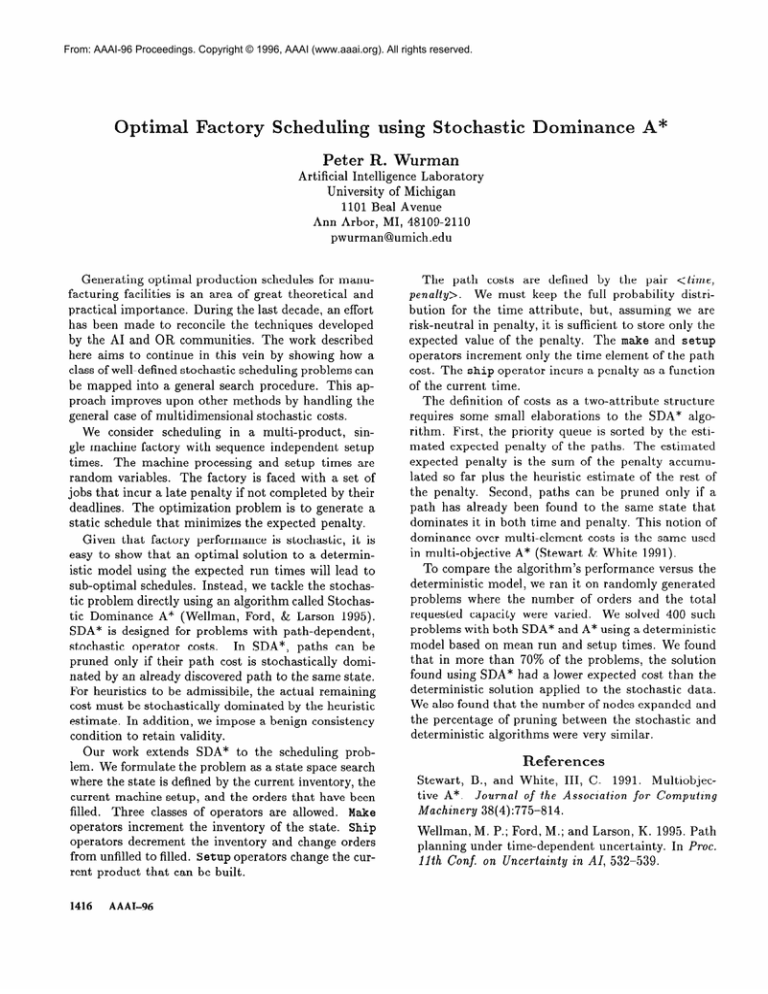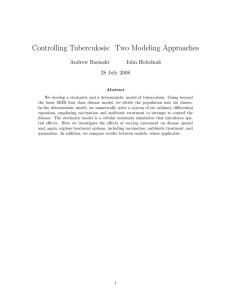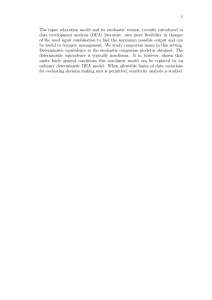
From: AAAI-96 Proceedings. Copyright © 1996, AAAI (www.aaai.org). All rights reserved.
Optimal
Factory
Scheduling
using Stm
Peter R. Wurman
Artificial
Intelligence
Laboratory
University of Michigan
1101 Beal Avenue
Ann Arbor, MI, 48109-2110
pwurman@umich.edu
Generating optimal production schedules for manufacturing facilities is an area of great theoretical and
practical importance.
During the last decade, an effort
has been made to reconcile the techniques developed
The work described
by the AI and OR communities.
here aims to continue in this vein by showing how a
class of well-defined stochastic scheduling problems can
be mapped into a general search procedure.
This approach improves upon other methods by handling the
general case of multidimensional
stochastic costs
We consider scheduling
in a multi-product,
single machine factory with sequence independent setup
times. The machine processing and setup times are
random variables.
The factory is faced with a set of
jobs that incur a late penalty if not completed by their
deadlines, The optimization
problem is to generate a
static schedule that minimizes the expected penalty.
Given that factory performance
is stochastic,
it is
easy to show that an optimal solution to a deterministic model using the expected run times will lead to
sub-optimal schedules. Instead, we tackle the stochastic problem directly using an algorithm called Stochastic Dominance A* (Wellman,
Ford, & Larson 1995).
SDA* is designed for problems with path-dependent,
stochastic
operator costs.
In SDA”,
paths can be
pruned only if their path cost is stochastically
dominated by an already discovered path to the same state.
For heuristics to be admissibile, the actual remaining
cost must be stochastically
dominated by the heuristic
estimate. In addition, we impose a benign consistency
condition to retain validity.
Our work extends SDA* to the scheduling problem. We formulate the problem as a state space search
where the state is defined by the current inventory, the
current machine setup, and the orders that have been
filled. Three classes of operators are allowed.
Make
operators increment the inventory of the state. Ship
operators decrement the inventory and change orders
from unfilled to filled. Setup operators change the current product that can be built.
1416
MI-96
The path costs are defined by the pair <time,
pen&y>.
We must keep the full probability
distribution for the time attribute,
but, assuming we are
risk-neutral in penalty, it is sufficient to store only the
expected value of the penalty.
The make and setup
operators increment only the time element of the path
cost. The ship operator incurs a penalty as a function
of the current time.
The definition of costs as a two-attribute
structure
requires some small elaborations
to the SDA* algorithm. First, the priority queue is sorted by the estimated expected penalty of the paths. The estimated
expected penalty is the sum of the penalty accumulated so far plus the heuristic estimate of the rest of
the penalty.
Second, paths can be pruned only if a
path has already been found to the same state that
dominates it in both time and penalty. This notion of
dominance over multi-element
costs is the same used
in multi-objective
A* (Stewart & White 1991).
To compare the algorithm’s performance versus the
deterministic model, we ran it on randomly generated
problems where the number of orders and the total
requested capacity were varied.
We solved 400 such
problems with both SDA* and A* using a deterministic
model based on mean run and setup times. We found
that in more than 70% of the problems, the solution
found using SDA* had a lower expected cost than the
deterministic
solution applied to the stochastic data.
We also found that the number of nodes expanded and
the percentage of pruning between the stochastic and
deterministic algorithms were very similar.
References
Stewart, B., and White, III, C. 1991. MultiobjecJournal
of the Assocaation for Computang
tive A”.
Machinery 38(4):775-814.
Wellman, M. P.; Ford, M.; and Larson, K. 1995. Path
planning under time-dependent
uncertainty. In Proc.
11th Conf. on Uncertainty in AI, 532-539.








